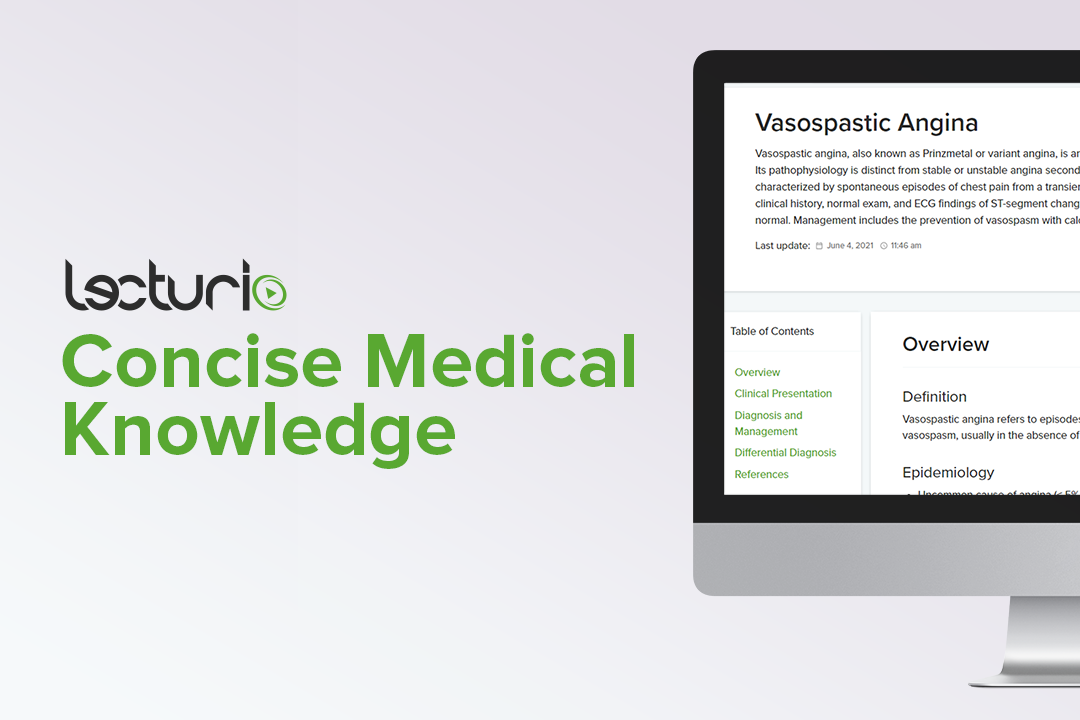Playlist
Show Playlist
Hide Playlist
Vasospastic Angina: Diagnosis
-
Slides Vasospastic Angina Cardiovascular Pathology.pdf
-
Download Lecture Overview
00:01 Vasospastic angina. Let's continue. The ST segments are transiently elevated resolves of the pain. Now remember, it can come as clusters. Key point, the cardiac enzymes are negative. 00:11 It rules out what please? Myocardial infarction. What are the two types that you should know? Once again, if it is transmural, you tell me what kind of blood vessel? Artery, arteriole? And I am hearing? Artery. Excellent. So, that will be transmural there will be an ST elevation. 00:28 Whereas if it was arteriole, then it will be a subendocardial MI and it will be a non-STEMI. 00:34 Maybe perhaps you will find a ST depression but the cardiac enzymes there wold be positive, here typically negative as they would be in almost all types of angina. Let's continue. 00:45 What do we say about the narrowing? Would you find narrowing if the coronary arteries have undergone a type of blundering effect? No. The catherization in angiography would find normal caliber of your coronary arteries. The definitive diagnosis, what do you do? Induction of vasospasm during the angiographies at least keep that concept in mind because you are not going to find actual blockage. Important here, be careful. So, what exactly are you trying to control? You are trying to control that vasospasm, aren't you? And let us make sure that we go back to our biochemistry and physio here to make sure that we can lead up into why calcium channel blockers are so important? Remember please. When we're doing our medicine here, it's the fact that our foundation has to be strong and you could get questions on the foundation, meaning phsio and biochem and then, of course, dealing with pharm or pathology. Here if you are thinking about calcium, what kind of muscle is blood vessel? Smooth muscle. Involuntary or voluntary? Obviously involuntary. You don't have to tell your blood vessels, please contract. That doesn't make any sense. 01:56 Next. You are talking about calcium calmodulin, aren't you? You should be thinking about alpha-1, aren't you? And when you do so, the calcium then brings about what kind of effect on your blood vessel, on smoth muscle? Contraction. Blood vessels cause vasoconstriction so therefore what do we try to do here with vasospastic? It is already in spasm, let us try to relax it. If you are trying to relax it, what might you want to do with your calcium? We are now trying to block effects of calcium. And by doing so you are relaxing the blood vessels. Ditiazem. Be careful, you do not want to use beta blockers. 02:29 Is that clear? Once again, beta blockers will be contraindicated in vasospastic disease. 02:35 Be careful. Now in addition, you also want to bring about relaxation. That is the bottom line, isosorbide mononitrate and that is a long-acting type of what? Take a look at the name here. The operative word, nitrate. What does that mean to you? Relaxation of your blood vessels. 02:54 Management. Well, there is another one. It is called Fasudil. 02:57 Rho-kinase inhibitor to prevent the release of acetocholine induced vasospasm. Once again, the objective with vasospastic is to do what? So make sure that you try to induce relaxation as much as possible.
About the Lecture
The lecture Vasospastic Angina: Diagnosis by Carlo Raj, MD is from the course Ischemic Heart Disease: Basic Principles with Carlo Raj.
Included Quiz Questions
Which of the following findings rules out myocardial infarction in the management of vasospastic angina?
- Negative cardiac enzymes
- Positive cardiac enzymes
- Positive troponin I
- ST-segment elevations
- ST-segment depressions
Which of the following medications is contraindicated in the treatment of vasospastic angina?
- Propranolol
- Diltiazem
- Calcium channel blockers
- Isosorbide mononitrate
- Sublingual nitroglycerin
What is the diagnostic test used in the management of vasospastic angina?
- Induction of vasospasm during angiography
- Induction of vasodilation during angiography
- Induction of vasospasm during angioplasty
- Induction of vasodilation during angioplasty
- Induction of ST-segment depression during angiography
Which of the following types of drugs are used in the management of vasospastic angina?
- Nitrates
- Alpha-blockers
- Beta-blockers
- ACE inhibitors
- Angiotensin receptor blockers
Customer reviews
5,0 of 5 stars
| 5 Stars |
|
5 |
| 4 Stars |
|
0 |
| 3 Stars |
|
0 |
| 2 Stars |
|
0 |
| 1 Star |
|
0 |




